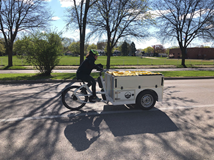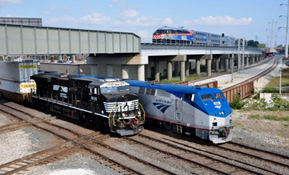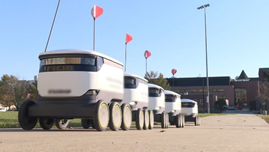
Moving goods to people and businesses is an essential part of building stronger regional economies, increasing community quality of life, and maintaining the nation's role in a global economy. While freight movement impacts livability and community quality of life, careful planning helps balance freight and livability needs. Communities can be aesthetically pleasing, safe, and walkable, while still providing efficient access for trucks, rail, and other modes of transportation. The Federal Highway Administration's livability principles call for expanding opportunities for economic development and revitalization, increasing community connectivity and cohesion, and decreasing the overall cost of moving goods.1 The U.S. transportation system moved nearly 51 million tons of raw materials and finished goods with a value of $51.8 billion per day in 2018, with steady growth expected over the next decade.2 Coordinated planning to maintain economic competitiveness includes identifying appropriate transportation investments to move goods through ports, and in and out of manufacturing and warehousing districts, while reducing carbon emissions, improving resiliency, and minimizing impacts on adjacent communities, especially to traditionally underserved communities. Planning for this growth–and the associated ports, shipping, warehousing, and manufacturing jobs–requires balancing the location and design of facilities for goods movement with context-sensitive design of multimodal transportation networks at the community and neighborhood level.

Regional freight planning can support livability. CREATE, or the Chicago Region Environmental and Transportation Efficiency program, is a $4.6 billion public-private partnership improving freight and livability in the Chicago area.3 CREATE is a partnership among the U.S. Department of Transportation (USDOT), the State of Illinois, City of Chicago, Cook County, Metra, Amtrak, and major North American freight railroads. The program makes critically needed improvements to increase the efficiency of the region's rail infrastructure. Since 2003, the following projects have received approval for funding and implementation:
CREATE projects construct roadway grade separations by building new overpasses and underpasses. In some cases, traffic, regardless of mode, no longer crosses railroad tracks, which increases safety, improves efficiency, and reduces emissions. For area residents, a roadway grade separation project means reduced traffic delays, shorter commute times, better air quality, and increased public safety. For workers and businesses, implementation of these projects means better access to jobs and enhanced economic opportunities.
Effective curbside management should enable freight access for loading and unloading. Washington, DC implemented the Curbside Loading Zone Management Program citywide in 2015, which improved travel times across multiple modes without a substantial disruption of commercial activity. The regulatory framework includes requirements for paid permits to use loading zones, enhanced enforcement, and data collection for improved management of loading zone demand.5 In 2019, DC carried out a pilot that replaced select on-street parking with temporary commercial pick-up/drop-off space to reduce illegal double-parking and safely and efficiently manage increasing operation of private vehicles in a commercial manner (e.g., food delivery). The pilot involved registration of drivers via a smartphone app whereby they could reserve and/or check-in to temporary loading spaces.6
Coordinating last mile deliveries provides broad benefits. The New York City DOT's urban freight initiatives under the Smart Truck Management Plan aim to "enhance the economic vitality and quality of life for all New Yorkers by providing for the safe, equitable, efficient, and environmentally responsible movement of goods."7 To reduce impacts of truck deliveries in neighborhood business districts during congested peak hours, USDOT partnered with New York City to create the Off-Hour Delivery Program. Instead of making deliveries during business hours, shipments are coordinated for delivery between 7 p.m. and 6 a.m. This effort reduces traffic congestion on the road during peak hours, resolves short-term parking issues for both cars and trucks, improves safety for pedestrians and bicyclists due to reduced truck double parking, and improves air quality. Through the program, the New York City DOT provides technical assistance (e.g., noise mitigation recommendations), facilitates collaboration across the delivery supply chain, and recognizes participants for adopting best practices.8 The increased efficiency indirectly benefits receiving businesses by reducing the truck carriers' costs and potentially not passing on those costs to the retailers/businesses.

The final 50 feet of deliveries matters. The University of Washington and the Urban Freight Lab is working with the City of Seattle to understand and optimize use of the truck load/unload network, which comprises curb space, alleyways, and loading docks and bays, by streamlining the final 50 feet of the supply chain (i.e., the movement of goods once a delivery vehicle is parked near the recipient's location). This research intends to identify strategies to reduce dwell time when delivery vehicles are parked and also reduce failed deliveries. These goals support reduced congestion on urban streets, improved safety for all road users, reduced limitation of bike lanes, air quality and noise impacts, and delivery costs. Furthermore, these goals can easily integrate with complete streets efforts by enabling safe travel for all users. Potential approaches to improve the final 50 feet of deliveries include creating incentives for urban building managers to provide "mini-distribution nodes" (e.g., lockers, concierge services) close to delivery vehicle load/unload areas, updating building codes for new construction to include private loading bays and/or docks, and using cargo bikes for deliveries in high density areas.9 These concepts are also being examined and implemented in other areas. In 2019, the New York City DOT began implementing a commercial cargo bike pilot to utilize the city's cycling infrastructure for more sustainable and efficient freight deliveries by electric pedal-assist bicycles.10
Emerging technologies may yield benefits for urban freight. Modern technologies that are enhancing urban freight transport include unmanned aircraft systems (UAS or drones), truck/delivery drone systems, and delivery robots. Drone technology can be applied to small and lightweight freight delivery applications in lower density urban/suburban areas due to its potential efficiency and cost benefits, reduction in automobile traffic, ability to serve those with mobility challenges, and reduction of environmental and climate impacts. 11 In 2017, the Federal Aviation Administration (FAA) began its UAS Integration Pilot Program bringing State, local, and Tribal governments together with UAS operators and manufacturers to test and evaluate the integration of civil and public drone operations into the national airspace system. Several participants in this pilot are demonstrating drone delivery capabilities for products including food in San Diego, California, packages in Herndon, Virginia, Memphis, Tennessee, and Raleigh, North Carolina; and medical equipment (e.g., defibrillators) in Reno, Nevada.12
1 Federal Highway Administration Office of Planning, Environment, and Realty. "Transportation and Livability." March 2018.
2 Bureau of Transportation Statistics. "Freight Facts and Figures." 2019.
3 Federal Highway Administration Center for Innovative Finance Support – Project Profile: Chicago Region Environment and Transportation Efficiency Program
4 CREATE Program. "About CREATE." "CREATE Project Websites." "CREATE Project Fact Sheets." June 2021.
5 Federal Highway Administration Office of Operations. "Noteworthy Practices: Commercial Loading Zone Management Program." March 2017.
6 DC Department of Transportation. "DDOT Announces Next Innovation in Curbside Management Program." June 2019.
7 Federal Highway Administration Office of Operations. "Talking Freight: Enhancing Urban Freight Planning Through Improving Last Mile Delivery." February 2019.
8 New York City Department of Transportation. "New York City Off-Hour Delivery Program."
9 Federal Highway Administration Office of Operations. "Talking Freight: Freight Deliveries and the Last 50 Feet of the Supply Chain." January 2018. Urban Freight Lab. "The Final 50 Feet Research Program: Optimizing the Last Leg of the Urban Goods Delivery System."
10 NYC.gov. "Mayor de Blasio Announces Commercial Cargo Bike Program to Reduce Delivery Congestion." December 2019.
11 Federal Highway Administration Office of Operations. "Talking Freight: The Impact of Emerging Technologies on Freight Transportation and Land Use." July 2019. "Talking Freight: Delivery by Drone: Examining Benefits, Impacts, and Regulations." September 2018.
12 Federal Aviation Administration. "UAS Integration Pilot Program." December 2019.